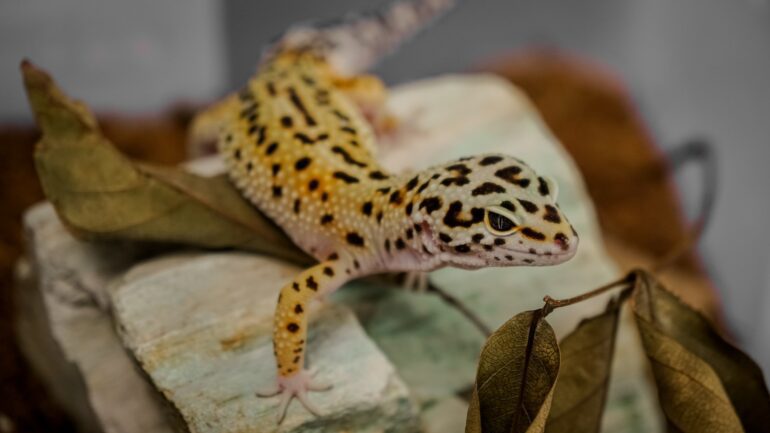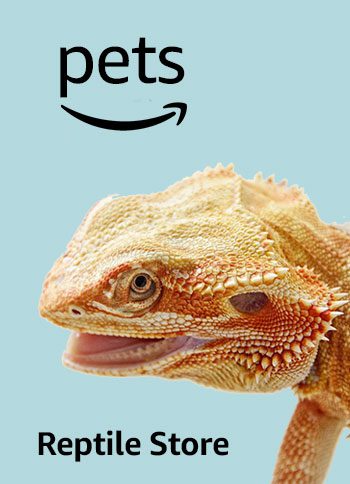There are a few things to consider when constructing a healthy environment for your pet gecko. Here are the four steps to a happy home for your scaly friend.
1. Pick a Tank—Construction and Size
The construction and size of the tank are important to keep your pet happy and thriving. The best material for your tank is glass or clear plastic. Any other material, like wire, may be dangerous and cause serious injury.
For one pet gecko, the ideal tank should be a minimum of 20 gallons. Your tank should measure 12 inches high and a minimum of 30 inches long. The bigger the tank, the happier your leopard gecko. Keep in mind that geckos are not big climbers; they thrive better in long and wide tanks.
Can Leopard Geckos Live Together?
Because gecko leopards are highly territorial and prefer to live in solitude it’s not a good idea to house two of them together. On rare occasions, female leopard geckos might get along. But it is almost guaranteed that housing two male leopard geckos will end with them fighting each other. Avoid cohabiting leopard geckos.
Security and Safety
The biggest threat for a gecko leopard is simple things around the house. For example, other pets or kids who might be curious to touch them. Ensure that your pet does not escape by securing and sealing all entry points. Remember, a removal screened top is necessary to allow proper ventilation and care.
Location of Your Tank
Placing your tank on a sturdy surface is the best way to avoid damage or accidents to your leopard gecko’s cage. You might also consider placing it on a higher level where small children won’t be tempted to disturb it. Avoid placing your tank in direct sunlight, as this may cause it to overheat.
Recommended Tanks for Your Leopard Gecko
- This 20-gallon white glass tank is aesthetically pleasing and a good starting tank if you only have one gecko.
- If you’d like to splurge on your pet gecko, this 50-gallon white glass tank is the best option.
- This traditional, 20-gallon black glass tank is a great starting point.
2. Choose a Substrate or Flooring Material
It’s necessary to pick out a safe and durable flooring material for your pet’s tank. Below are the best flooring recommendations and the ones you should avoid.
Recommended Substrates
- Reptile Carpets – Special, thin carpeting strips made for reptile tanks are an affordable option and preferred by gecko owners. They are easy to maintain, but once you notice wear or tears you must replace them. It may be hazardous if your lizard’s claws get caught.
- Ceramic tile – Easy to clean and inexpensive. A plus, they are aesthetically pleasing, customizable and easily replaced if needed.
- Non-adhesive shelf liner – Affordable, customizable and can easily be cleaned.
- Newspaper or Paper Towels – An easy alternative and require no clean up. If you’re a busy person, this might be a great option to consider.
Subtrates To Avoid
While options vary for substrates there are some that may jeopardize your pet’s safety. Please avoid the following flooring material.
- Sand – Many experts warn against the use of sand in a gecko leopard’s tank. It is known to irritate both the eyes and skin of a gecko. Additionally, if your pet consumes the material it may be deadly. Another downside is that sand is often messy and expensive.
- Calcium Fortified Sand – This should also be avoided, although not deadly if consumed. Over time, it can become clumpy and create digestive issues for your pet gecko.
- Mulch – Dangerous if ingested, but can also cause humidity issues within your pet’s tank. It’s also considered a messier option to clean up. Mulch is only acceptable to use underneath the moist hide in your tank, but more on this later.
3. Create the Right Environment
It’s necessary to imitate the conditions of your pet’s natural environment as closely as possible to maintain a happy gecko leopard. Here are the three things needed for creating a healthy habitat.
Lighting
Consider the following to regulate your gecko’s sleeping and walking rhythms. In the summer, 14 hours of visible light per day and 10 hours of darkness are crucial to your pet’s health. During winter, change their environment by providing only 12 hours of light and 12 hours of dark. When transitioning light exposure between seasons, do so gradually, in 15–30 minute increments per day.
Do Leopard Geckos Need UVB Lighting?
Because leopard geckos are nocturnal, they do not need UVB lighting to survive. However, your gecko might benefit from UVB light. This type of lighting has proven to help synthesize vitamin D3 and help leopard geckos absorb calcium.
Proper Temperatures
Leopard geckos require a warm and cool environment. You should keep the cool side of the enclosure at about 75–80 degrees in the daytime and the warm side at 84–90 degrees. At night, lower the cool side by 10 degrees.
- Reptile heating mats – The heat that is generated through these pads is safe and avoids introducing bright light to the tank. Place these mats underneath the tank.
- Heat Lamps – Do leopard geckos need a heat lamp? The short answer—it depends. Heat lamps can help if your heating mat is not warm enough. Although they are not highly recommended, because leopard geckos have sensitive eyes.
- Thermometers – This is the best tool to ensure your gecko does not suffer overly cold or warm days/nights. You will need at least two to ensure accurate readings.
Humidity
It’s important to have the proper amount of humidity in your leopard gecko’s tank. Too much humidity can cause respiratory problems, and too little can lead to dehydration. To measure the humidity, you can purchase a special gauge. An adequate amount of humidity is usually between 20–40 %.
Decrease Humidity Levels
Air circulation can help lower humidity levels. Reducing the amount of water in the water dish can also help lower humidity.
Increase Humidity Levels
Live plants can help increase humidity levels. Another method to increase humidity is adding a larger water bowl. Adding moss or damp paper towels to the enclosure is also a good alternative.
4. Add Accessories and Decorations To Create a Home
After considering the crucial parts of a leopard gecko environment, now you can have fun. Adding accessories and decorations is a great way to make sure your pet feels safe and at home.
Accessories and Decorations To Consider
- Plants – As mentioned above, plants are a great way to help humidity levels, but also help to add a natural element. If your humidity levels are stable, you can opt for artificial varieties. Because leopard geckos don’t eat plants, you don’t have to worry too much about what you choose to put in their tank; they are not likely to ingest the plants. Just be sure to avoid anything poisonous.
- Hides – A “hide” is a place where your leopard gecko can shield itself. Cool, dark places are necessary for the health of your gecko. Ideally, you’ll want three hides to place around your pet’s tank. One for the warm side, one in the middle and the other for the cool side of the tank.
- Rocks and Logs – These are good alternatives to store-bought hides. But make sure what you’re putting in your critter’s habitat is not contaminated in any way. It’s best to clean anything before placing it in the tank.




